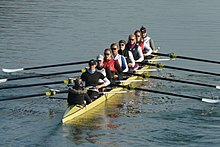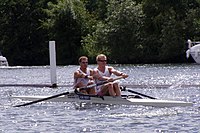
Rowing, sometimes called crew in the United States, is the sport of racing boats using oars. It differs from paddling sports in that rowing oars are attached to the boat using oarlocks, while paddles are not connected to the boat. Rowing is divided into two disciplines: sculling and sweep rowing. In sculling, each rower holds two oars, one in each hand, while in sweep rowing each rower holds one oar with both hands. There are several boat classes in which athletes may compete, ranging from single sculls, occupied by one person, to shells with eight rowers and a coxswain, called eights. There are a wide variety of course types and formats of racing, but most elite and championship level racing is conducted on calm water courses 2 kilometres (1.2 mi) long with several lanes marked using buoys.

An outrigger is a projecting structure on a boat, with specific meaning depending on types of vessel. Outriggers may also refer to legs on a wheeled vehicle that are folded out when it needs stabilization, for example on a crane that lifts heavy loads.
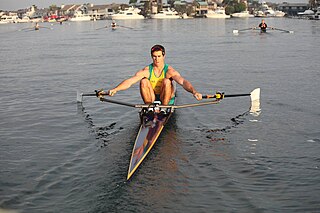
Sculling is the use of oars to propel a boat by moving them through the water on both sides of the craft, or moving one oar over the stern. A long, narrow boat with sliding seats, rigged with two oars per rower may be referred to as a scull, its oars may be referred to as sculls and a person rowing it referred to as sculler.

Rowing is the act of propelling a human-powered watercraft using the sweeping motions of oars to displace water and generate reactional propulsion. Rowing is functionally similar to paddling, but rowing requires oars to be mechanically attached to the boat, and the rower drives the oar like a lever, exerting force in the same direction as the boat's travel; while paddles are completely hand-held and have no attachment to the boat, and are driven like a cantilever, exerting force opposite to the intended direction of the boat.
In competitive rowing, the following specialized terms are important in the corresponding aspects of the sport:

Harry Clasper was a professional rower and boat builder from Tyneside in England. He was an innovative boat designer who pioneered the development of the racing shell and the use of outriggers. He is said to have invented spoon-shaped oars.

In rowing, oars are used to propel the boat. Oars differ from paddles in that they use a fixed or sliding fulcrum, an oarlock or rowlock attached to the side of the boat, to transfer power from the handle to the blade, rather than using the athlete's shoulders or hands as the pivot-point as in canoeing and kayaking.

A coxless pair, abbreviated as a 2- and also known as a straight pair, is a racing shell used in the sport of competitive rowing. It is designed for two rowers, who propel the boat with sweep oars.
In the sport of rowing, each rower is numbered by boat position in ascending order from the bow to the stern. The person who is seated on the first seat is always the 'bow', the closest to the stern is commonly referred to as the 'stroke'. There are some exceptions to this: Rowers in continental Europe number from stern up to bow. Certain crew members have other informal titles and roles. Stroke seat in most cases is responsible for keeping pace for the boat, while the coxswain is responsible for the steering of the boat.

A single scull, abbreviated as a 1x, is a racing shell designed for a single person who propels the boat with two oars, one in each hand.
Boats used in the sport of rowing may be adjusted in many different ways according to the needs of the crew, the type of racing, and anticipated rowing conditions. The primary objective of rigging a boat is to accommodate the different physiques and styles of rowing of the crew in such a way that the oars move in similar arcs through the water, thus improving the crew's efficiency and cohesiveness.

A quadruple sculling boat, often simply called a quad and abbreviated as a 4x, is a racing shell used in the sport of competitive rowing. It is designed for four people who propel the boat by sculling with two oars, or "sculls", one in each hand.
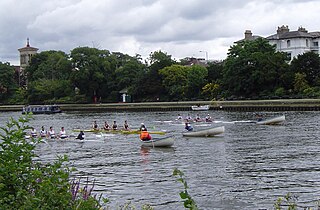
A coxed four, abbreviated as a 4+, is a racing shell used in the sport of competitive rowing. It is designed for four persons who propel the boat with sweep oars and is steered by a coxswain.
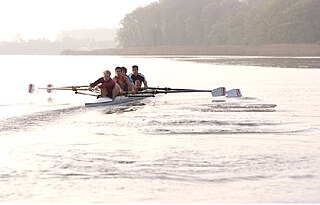
A coxless four, abbreviated as a 4- and also called a straight four, is a racing shell used in the sport of competitive rowing. It is designed for four persons who propel the boat with sweep oars, without a coxswain.

A coxed pair, abbreviated as a 2+, is a racing shell used in the sport of competitive rowing. It is designed for two persons who propel the boat with sweep oars and is steered by a coxswain (cox).
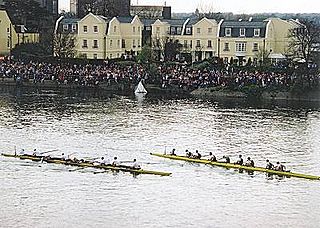
An eight, abbreviated as an 8+, is a racing shell used in competitive rowing (crew). It is designed for eight rowers, who propel the boat with sweep oars, and is steered by a coxswain, or "cox".

Sweep rowing is one of two disciplines of the sport of rowing. In sweep rowing each rower has one oar, usually held with both hands. As each rower has only one oar, the rowers have to be paired so that there are equal numbers of oars on each side of the boat. In the United Kingdom, rowing generally refers to sweep rowing only. The term pulling was also used historically. In the other rowing discipline, sculling, each rower holds two oars, one in each hand.

An octuple sculling shell, often simply called an oct and abbreviated as an 8x or 8x+, is a racing shell used in the sport of rowing.

Human-powered watercraft are watercraft propelled only by human power, instead of being propelled by wind power or an engine.

Alden Rowing manufactures sliding-seat rowing boats. Their original product, the Alden Ocean Shell, was designed in 1970 or 1971. Traditional shell designs use high aspect ratio hulls, with long waterline with minimum beam, that emphasize racing performance at the cost of stability. These types of boats are only usable on flat water. Alden, however, specializes in shorter, beamier, highly stable designs which are suitable for rowing in open water, where swells are commonly encountered. As of 2004, Alden had sold 25,000 shells.
